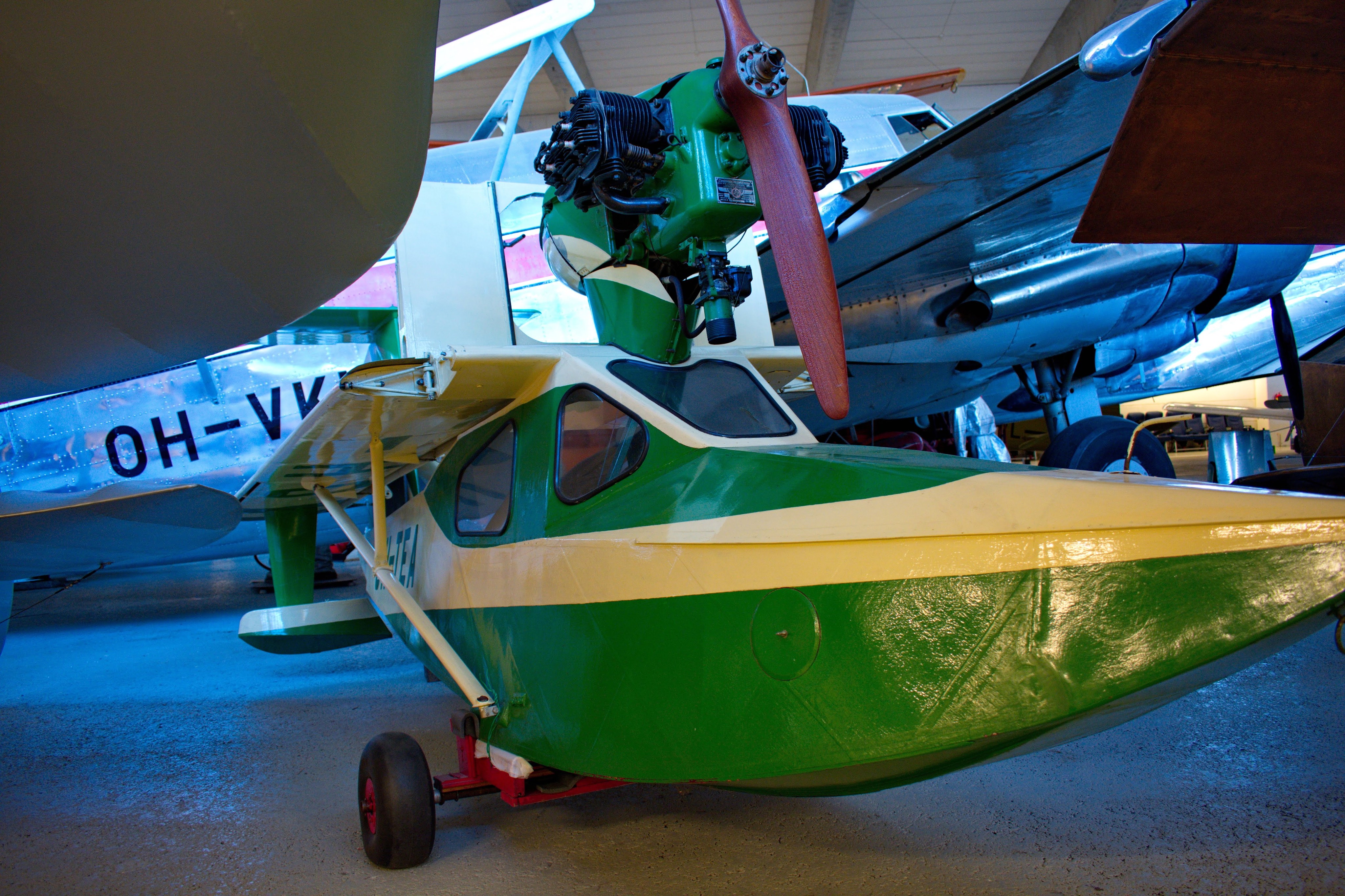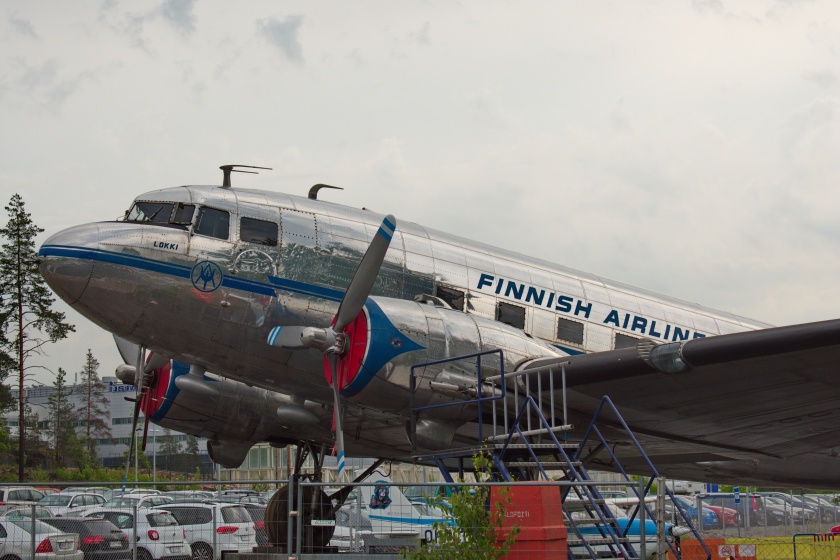One of the main advantages of being an expat is having other expat connections. It was one of these wonderful ladies who made me aware of the Airplane Museum in Helsinki, a museum that seems to be little-known, even among locals. Of course, as soon as I heard about it, I knew I had to go. Aviation really gets in your blood, and even though it’s been three years since I’ve worked for an airline, the pull is still strong. Plus: Airplanes!!
Getting there
The museum, called the Suomen Ilmailumuseo in Finnish, is located next to the airport. From the train station in Helsinki, you can take either the I or P train (the P train is faster in this direction; I take the I train home), and get off at Aviapolis. Take the exit toward Aviabulevardi and when you eventually make it to the surface, turn right and walk along the Clarion hotel until you can look left and see an airplane on display. Don’t let the fencing fool you, it’s perfectly acceptable to walk through the gate to the museum. It is housed in an old aircraft hanger, after all, so it makes sense that it would be fenced if it used to be part of the airfield.
The Museum
The 10€ entrance fee is totally worth it (children under 7 are free), and I was giddy when I walked into the first exhibition room. I should probably point out that I went twice; once with Little Man, who had a great time running around all the planes and climbing the stairs (which are old air stairs used for boarding planes from the tarmac), and once on my own, so I could actually look at the planes. The hangers may be spacious, but they are packed with aircraft. There are two main rooms, separated by a “family relaxing room” (including a couch, small play area with aviation-themed toys, a tv showing something about flying, and a hot air balloon basket), as well as a decent-sized cafe near the entrance.

It’s recommended, especially in the winter, to wear appropriate clothing as the exhibition halls are not heated. For more information about the museum, click here. Okay, now on to the planes!

This plane made its first flight on 23 February 1949. It was originally designed by Torolf Eklund as an amphibian with a 28 horse power engine. However, it was found to be under-powered, so a 40 HP engine was installed, the landing gear removed, and it became the worlds smallest flying boat. I don’t know about you, but I’ve never heard of a flying boat!

This plane was the first jet engine trainer in the Finnish Air Force (FAF). Nine of these beauties were in use between 1955-65. It was also the first aircraft in Finland with ejection seats. Have you ever thought beyond the ejection? I’m a little disappointed to say that I never did. Until I saw the supplies these planes were stocked with.

This was supposedly everything a person would need to survive until rescue after ejecting from an aircraft. Do you think it’s sufficient?

This little guy was built in 1922, making it the oldest surviving aircraft to be built in Finland. It is classified as a three-seat license built maritime scoutplane. The FAF had 120 of these in use from 1922-36. I can’t imagine fitting three people in here; I stand at least two feet higher than the roof.

This is the only Finnish aircraft to have achieved a world’s record. Designed and built by engineer Juhani Heinonen in 1954, he then made a record long distance flight on 10 July 1957. The flight from Madrid to Turku was 2,844 kilometers and took 17 hours 1 minute to complete. This took the world record for a single-engine land plane with a maximum take-off weight of 500 kilos. The record stayed with this aircraft until 1974.

I do believe this is the only commercial aircraft in the museum. It was amongst the first three Convair airliners ordered by Aero Ltd in 1951. It was manufactured in San Diego, CA in April 1953, and flown to Finland a month later. Originally built as a 44-seat Conavair 340 type airliner, it was later converted to a 52-seat Convair 440 “Metropolitan” in 1956. This is the longest serving aircraft in the history of Finnair. It flew its last flight on 30 April 1980, after which it was donated to the Finnish Aviation Museum.
But the best part of this plane is that you’re allowed to go inside! There are only a few seats open to be sat in, and you’re not allowed in the cockpit, but it’s super cool to see how much planes have changed over the years!

I think my favorite part was the purple seats. It also still smells faintly of smoke, since smoking on flights was fashionable when this aircraft was in service.
Last but not least:

I’ve saved this plane for last for a couple of reasons: One, it’s got a pretty fascinating history, and two, anyone notice the swastika painted on the side? Yeah, I’ll get to that.
Firstly, this is the sole surviving aircraft of this type in the world. It was designed and built in the Soviet Union in 1937. The FAF used it from 1941-42. It is also the only remaining plane of the 90 Soviet aircraft captured during the war.
It is NOT, however, the only Finnish plane with a swastika. Finland’s use of the now notorious symbol predates that of Hitler’s Nazis by a good decade. In 1918, the Finnish White Army was fighting a battle against Soviet-backed Red Guards in hopes of establishing an independent Finland. A Swedish count, Eric von Rosen, had a swastika painted on the wings of an aircraft which he donated to the White Army. After the Whites won, the swastika became a symbol of freedom and independence, as well as the official symbol of the Finnish Air Force. This remained the case until after WWII. As you can imagine, not many people were fans of the swastika at that time and, having signed a post-war armistice with the United States and the Soviet Union (and probably a few other countries), Finland agreed to no longer paint the swastika on their military aircraft.
Interestingly, it is still a part of the FAF emblem and can be found on numerous wartime monuments around Helsinki. There is quite a debate about whether or not that should change. (The best article I found on the subject is this one. It freely shows both sides and is very informative.) I’ll let you draw your own conclusions on the subject. I for one don’t think it’s a black and white issue.
Questions: Which was your favorite airplane?
What do you think of the Finnish swastika?



Wonderful, dear. Thank you for sharing your experience and your wonderful pictures. I Like and I Share. Take care.
LikeLiked by 1 person
Thank you. I’m glad you enjoyed this post.
LikeLike
Hello Emily.
You made a very wonderful post! Well written, full of information and presenting gorgeous photos. I know this museum and visited there twice in my life, not made a post about it. In Finland we have nearby the town of Jyväskylä more better air museum. I think that there is some interest to You also, because there is a war craft which is unique in the world and it is from Your country! I suggest You see my post:
Aviation Museum of Central Finland
Happy weekend!
LikeLike
Thank you, Matti, I’m glad you enjoyed my post. I think I’ve heard of the Aviation Museum (possibly while researching for my post). Your photos are lovely. I think it’s so neat that they pulled the Brewster out of the lake and restored it! Thank you for sharing.
I also enjoyed your post about the coffee cup museum; that’s my dream collection. 😊
LikeLiked by 1 person
Really interesting read, I had no idea the Swastika had such an association with Finland. I can imagine it’s pretty controversial about its use now. If you ever visit Sydney they’ve got a few Swastika’s along the floor of the Customs House building for similar reasons and predates World War Two.
LikeLiked by 1 person
Yeah, it’s quite an interesting topic if you dig into it.
I had no idea other countries also used swastikas. Some day I will get to Australia! I’ll have to check it out.
LikeLiked by 1 person